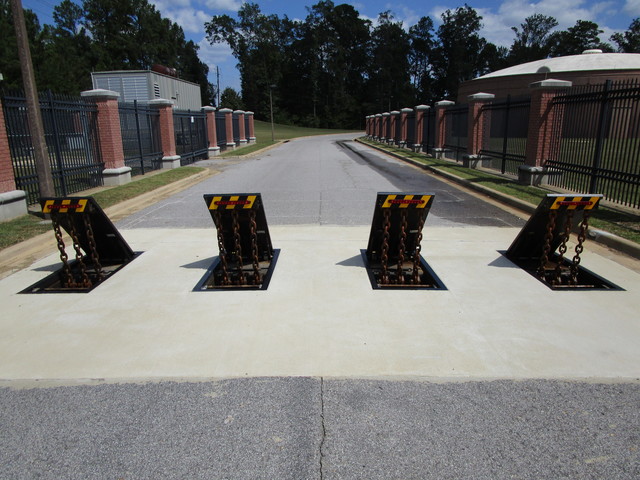The Buzz on Wedge Barriers
5 Easy Facts About Wedge Barriers Described
Table of ContentsOur Wedge Barriers DiariesWedge Barriers Fundamentals Explained

Wedge Barriers - Questions
The remaining pressure used to
the cam to deploy the wedge plate 16 may might provided by an electromechanical actuator 84 or other actuator. The spring setting up 54 and the actuator 84(e. Wedge Barriers. g., electromechanical actuator)may operate together to equate the webcam and lift the wedge plate 16.
As mentioned above, the spring setting up 54 applies a continuous pressure on the cam, while the electromechanical actuator might be controlled to apply a variable force on the webcam, consequently enabling the training and lowering( i. e., deploying and withdrawing )of the wedge plate 16. In particular personifications, the constant pressure used by the springtime setting up 54 might be adjustable. g., electromechanical actuator) is impaired. As will certainly be appreciated, the spring assembly 54 may be covered and safeguarded from particles or various other components by a cover plate(e. g., cover plate 68 received FIG. 4) that may be significantly flush with the raised surface area 38 of the structure 14. As pointed out above, in the released position, the wedge plate 16 serves to obstruct gain access to or travel past the obstacle 10. As an example, the obstacle 10(e. g., the wedge plate 16 )may obstruct pedestrians or lorries from accessing a residential or commercial property or pathway. As talked about above, the barrier 10 is attached to the anchor 30 secured within the foundation 14,

front braces 71. Consequently, the my link affiliation settings up 72 may pivot and turn to make it possible for the collapse and extension of the affiliation assemblies 72 during retraction and deployment of the bather 10. The linkage settings up 72 reason movement of the wedge plate 16 to be restricted. As an example, if a lorry is taking a trip towards the released wedge plate 16(e. For instance, in one circumstance, the security legs 86 may be prolonged duringmaintenance of the barrier 10. When the safety and security legs 86 are released, the safety and security legs 86 sustain the weight of the wedge plate 16 versus the surface area 12. Because of this, the see post lifting system 50 may be deactivated, serviced, gotten rid of, changed, etc. FIG. 5 is partial perspective view of an embodiment of the surface-mounted wedge-style obstacle 10, illustrating the webcam 80 and the cam surfaces 82 of the training mechanism 50. Especially, 2 web cam surface areas 82, which are described as lower webcam surface areas 83, are placed below the webcam 80. The lower webcam surfaces 83 may be dealt with to the surface 12 (e. For example, the reduced webcam surfaces 83 and the installing plate 85 might form a solitary piece that is protected to the anchor 30 by bolts or other mechanical fasteners. Furthermore, 2 webcam surfaces 82, which are described as top webcam surfaces 87, are positioned above the web cam 80 and combined to (e. In various other embodiments, stepping in layers or plates might be positioned between the surface area 12 and the lower web cam surface areas 83 and/or the wedge plate 16 and the top cam surfaces 87 As discussed check here over, the web cam
80 equates along the webcam surfaces 82 when the wedge plate 16 is raised from the withdrawed setting to the released placement. Additionally, as pointed out above, the spring assembly 54 (see FIG. 3 )may give a force acting upon the cam 80 in the instructions 102 by means of spring rod 58, which might minimize the pressure the electromechanical actuator 84 is needed to put on the web cam 80 in order to actuate and raise the wedge plate 16. 1 )to the deployed setting(see FIG. 4). As shown, the camera 80 consists of track wheels 104(e. g., rollers), which get in touch with and convert along the web cam surface areas 82 during procedure.